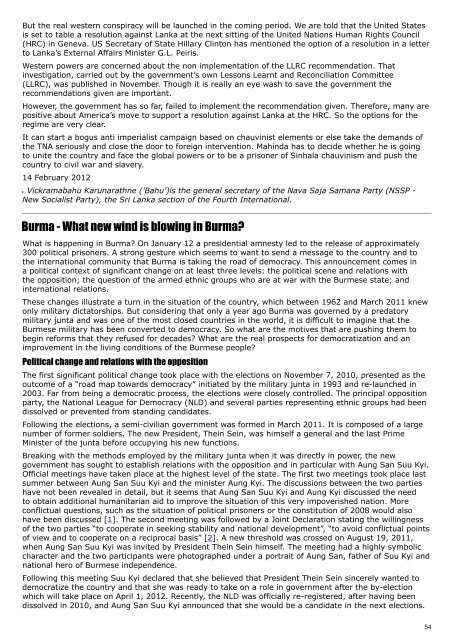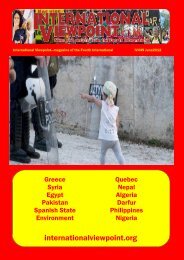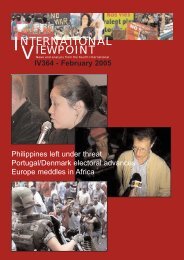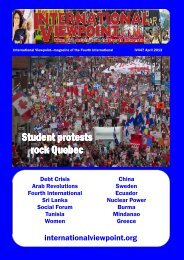download - International Viewpoint
download - International Viewpoint
download - International Viewpoint
Create successful ePaper yourself
Turn your PDF publications into a flip-book with our unique Google optimized e-Paper software.
But the real western conspiracy will be launched in the coming period. We are told that the United States<br />
is set to table a resolution against Lanka at the next sitting of the United Nations Human Rights Council<br />
(HRC) in Geneva. US Secretary of State Hillary Clinton has mentioned the option of a resolution in a letter<br />
to Lanka’s External Affairs Minister G.L. Peiris.<br />
Western powers are concerned about the non implementation of the LLRC recommendation. That<br />
investigation, carried out by the government’s own Lessons Learnt and Reconciliation Committee<br />
(LLRC), was published in November. Though it is really an eye wash to save the government the<br />
recommendations given are important.<br />
However, the government has so far, failed to implement the recommendation given. Therefore, many are<br />
positive about America’s move to support a resolution against Lanka at the HRC. So the options for the<br />
regime are very clear.<br />
It can start a bogus anti imperialist campaign based on chauvinist elements or else take the demands of<br />
the TNA seriously and close the door to foreign intervention. Mahinda has to decide whether he is going<br />
to unite the country and face the global powers or to be a prisoner of Sinhala chauvinism and push the<br />
country to civil war and slavery.<br />
14 February 2012<br />
Vickramabahu Karunarathne (’Bahu’)is the general secretary of the Nava Saja Samana Party (NSSP -<br />
New Socialist Party), the Sri Lanka section of the Fourth <strong>International</strong>.<br />
Burma - What new wind is blowing in Burma?<br />
What is happening in Burma? On January 12 a presidential amnesty led to the release of approximately<br />
300 political prisoners. A strong gesture which seems to want to send a message to the country and to<br />
the international community that Burma is taking the road of democracy. This announcement comes in<br />
a political context of significant change on at least three levels: the political scene and relations with<br />
the opposition; the question of the armed ethnic groups who are at war with the Burmese state; and<br />
international relations.<br />
These changes illustrate a turn in the situation of the country, which between 1962 and March 2011 knew<br />
only military dictatorships. But considering that only a year ago Burma was governed by a predatory<br />
military junta and was one of the most closed countries in the world, it is difficult to imagine that the<br />
Burmese military has been converted to democracy. So what are the motives that are pushing them to<br />
begin reforms that they refused for decades? What are the real prospects for democratization and an<br />
improvement in the living conditions of the Burmese people?<br />
Political change and relations with the opposition<br />
The first significant political change took place with the elections on November 7, 2010, presented as the<br />
outcome of a “road map towards democracy” initiated by the military junta in 1993 and re-launched in<br />
2003. Far from being a democratic process, the elections were closely controlled. The principal opposition<br />
party, the National League for Democracy (NLD) and several parties representing ethnic groups had been<br />
dissolved or prevented from standing candidates.<br />
Following the elections, a semi-civilian government was formed in March 2011. It is composed of a large<br />
number of former soldiers. The new President, Thein Sein, was himself a general and the last Prime<br />
Minister of the junta before occupying his new functions.<br />
Breaking with the methods employed by the military junta when it was directly in power, the new<br />
government has sought to establish relations with the opposition and in particular with Aung San Suu Kyi.<br />
Official meetings have taken place at the highest level of the state. The first two meetings took place last<br />
summer between Aung San Suu Kyi and the minister Aung Kyi. The discussions between the two parties<br />
have not been revealed in detail, but it seems that Aung San Suu Kyi and Aung Kyi discussed the need<br />
to obtain additional humanitarian aid to improve the situation of this very impoverished nation. More<br />
conflictual questions, such as the situation of political prisoners or the constitution of 2008 would also<br />
have been discussed [1]. The second meeting was followed by a Joint Declaration stating the willingness<br />
of the two parties “to cooperate in seeking stability and national development”, “to avoid conflictual points<br />
of view and to cooperate on a reciprocal basis” [2]. A new threshold was crossed on August 19, 2011,<br />
when Aung San Suu Kyi was invited by President Thein Sein himself. The meeting had a highly symbolic<br />
character and the two participants were photographed under a portrait of Aung San, father of Suu Kyi and<br />
national hero of Burmese independence.<br />
Following this meeting Suu Kyi declared that she believed that President Thein Sein sincerely wanted to<br />
democratize the country and that she was ready to take on a role in government after the by-election<br />
which will take place on April 1, 2012. Recently, the NLD was officially re-registered, after having been<br />
dissolved in 2010, and Aung San Suu Kyi announced that she would be a candidate in the next elections.<br />
54









